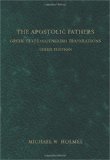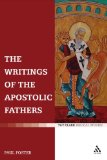|
Relevant
books available at Amazon
 
Michael Holmes ---------------
 
Bart Ehrman ---------------
 
Paul Foster
|
Chapter 9: 6-9
But thou wilt say, “Yea, verily the people are circumcised for a seal.” But so
also is every Syrian and Arab, and all the priests of idols: are these then also
within the bond of His covenant? Yea, the Egyptians also practise circumcision.
Learn then, my children, concerning all things richly, that Abraham, the first
who enjoined circumcision, looking forward in spirit to Jesus, practised that
rite, having received the mysteries of the three letters. For [the Scripture] saith, “And Abraham circumcised ten, and eight, and three hundred men of his
household.” What, then, was the knowledge given to him in this? Learn the
eighteen first, and then the three hundred. The ten and the eight are thus
denoted—Ten by Ι, and Eight by Η. You have [the initials of the, name of] Jesus.
And because the cross was to express the grace [of our redemption] by the letter
Τ, he says also, “Three Hundred.” He signifies, therefore, Jesus by two letters,
and the cross by one. He knows this, who has put within us the engrafted gift of
His doctrine. No one has been admitted by me to a more excellent piece of
knowledge than this, but I know that ye are worthy.
Chapter 12: 1-7
In like manner He points to the cross of Christ in another prophet, who saith,
“And when shall these things be accomplished? And the Lord saith, When a tree
shall be bent down, and again arise, and when blood shall flow out of wood.”
Here again you have an intimation concerning the cross, and Him who should be
crucified. Yet again He speaks of this in Moses, when Israel was attacked by
strangers. And that He might remind them, when assailed, that it was on account
of their sins they were delivered to death, the Spirit speaks to the heart of
Moses, that he should make a figure of the cross, and of Him about to suffer
thereon; for unless they put their trust in Him, they shall be overcome for
ever. Moses therefore placed one weapon above another in the midst of the hill,
and standing upon it, so as to be higher than all the people, he stretched forth
his hands, and thus again Israel acquired the mastery. But when again he let
down his hands, they were again destroyed. For what reason? That they might know
that they could not be saved unless they put their trust in Him. And in another
prophet He declares, “All day long I have stretched forth My hands to an
unbelieving people, and one that gainsays My righteous way.” And again Moses
makes a type of Jesus, [signifying] that it was necessary for Him to suffer,
[and also] that He would be the author of life [to others], whom they believed
to have destroyed on the cross when Israel was failing. For since transgression
was committed by Eve through means of the serpent, [the Lord] brought it to pass
that every [kind of] serpents bit them, and they died, that He might convince
them, that on account of their transgression they were given over to the straits
of death. Moreover Moses, when he commanded, “Ye shall not have any graven or
molten [image] for your God,” did so that he might reveal a type of Jesus. Moses
then makes a brazen serpent, and places it upon a beam, and by proclamation
assembles the people. When, therefore, they were come together, they besought
Moses that he would offer sacrifice in their behalf, and pray for their
recovery. And Moses spake unto them, saying, “When any one of you is bitten, let
him come to the serpent placed on the pole; and let him hope and believe, that
even though dead, it is able to give him life, and immediately he shall be
restored.” And they did so. Thou hast in this also [an indication of] the glory
of Jesus; for in Him and to Him are all things.
|

